
Structured vs Unstructured Play: Benefits for Toddlers
If you’re a parent of a busy toddler, you probably know that playtime isn’t always as peaceful or organized as we imagine. One moment they’re quietly stacking blocks, and the next they’re climbing your couch like it’s a mountain. As moms and dads, we want our little ones to play freely, but we also want them safe, and maybe keep our living room in one piece, too.
Let’s explore how structured and unstructured play areas can make such a difference. It’s not about picking one over the other, but finding the right balance that fits your child’s needs (and your sanity). Let’s break it down in a way that makes sense for real life.
What is Structured Play?
Structured play is any kind of play that has a bit of a plan or goal behind it. Think of it as play with a purpose and guided by you, another adult, or even the setup of the space itself.
Examples include:
-
A climbing structure designed to help your toddler practice balance and coordination
-
A play kitchen where your little one “cooks” along with you
-
Simple games like “Simon Says” or a scavenger hunt
Structured play helps toddlers follow directions, build confidence, and develop focus while having fun. It’s also a great way to teach new skills in a safe and controlled setting.
What is Unstructured Play?
Now, unstructured play is the total opposite. It’s free play, led by your child’s imagination. No rules, no goals, just creativity flowing. It’s the kind of play that happens when your toddler decides their tower is a pirate ship or that your sofa cushions are stepping stones across a lava floor.
Unstructured play encourages problem-solving, independence, and emotional expression. It’s how toddlers make sense of the world around them, one pretend adventure at a time.
The beauty of unstructured play is that it gives kids the freedom to explore their ideas without pressure. Sometimes, as parents, it can feel messy, but it’s also where so much growth happens.
Why Both Types of Play Matter
Here’s the truth: toddlers need both structured and unstructured play.
Structured play helps build physical and mental skills like coordination, memory, and following directions, while unstructured play develops creativity, confidence, and independence.
Think of it like this: structured play provides the “tools,” and unstructured play teaches them how to use those tools in their own way.
For example, a climbing structure like a Montessori-inspired play gym gives your child a safe, supportive space to move their bodies. You can guide them at first (structured play), but soon they’ll start exploring on their own and figuring out new ways to climb, jump, and balance (unstructured play).
It’s all connected, and both types of play support each other beautifully.
How to Create Structured and Unstructured Play Spaces at Home
You don’t need a big playroom or fancy equipment to give your toddler what they need. You just need a thoughtful setup that encourages both types of play. Here are a few simple ideas:
1. Set up a Safe Climbing Zone
If your little one loves to climb everything in sight, consider giving them a designated space with solid, stable play furniture or a small climbing structure. It gives them a safe outlet for their energy and supports muscle development, plus, it saves your furniture from constant “mountain climbs.”
2. Use Furniture That Grows with Them
Choose pieces that can shift between guided and independent play. A learning tower, for example, can be used during structured play when helping you in the kitchen and during unstructured moments when they decide to turn it into a fort or rocket ship.
3. Keep It Open-Ended
Provide toys and furniture that don’t dictate exactly how to play. Open-ended setups inspire imagination, such as blocks, tunnels, and climbing frames let kids invent new stories every time.
4. Rotate Toys and Play Spots
Too many options can overwhelm toddlers. Rotating their play items keeps things fresh and exciting. You can also create “zones”: one for quiet play, one for active movement, one for creative messes.
5. Follow Their Lead
Sometimes, the best thing we can do is just watch and join in when they invite us. Let them decide how to play, even if it looks a little silly to us. That’s how their confidence grows.
The Parent Perspective
As parents, it’s easy to feel torn. We want to guide our toddlers and make sure they’re learning, but we also don’t want to hover or limit their imagination. It helps to remember that both structured and unstructured play are part of healthy development.
Some days, your toddler will want to follow your lead. Other days, they’ll want to do everything “by myself!” And that’s perfectly okay. Every climb, tumble, and giggle is helping them grow stronger, smarter, and more confident.
At the end of the day, playtime is all about keeping them busy and genuine connection. It’s those little moments of laughter and discovery that make parenting so special.
Creating the Perfect Play Space
If you’re ready to make your home a place where your toddler can safely explore, climb, and imagine, we’d love to help.
At Mommy’s Little Helper Co., our play furniture is designed with real families in mind. Durable, beautiful, and safe enough for the most curious little adventurers. Whether it’s a learning tower for everyday moments or a foldable play set for bigger adventures, our pieces grow with your child and fit seamlessly into your home. Explore our collection today.



